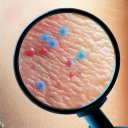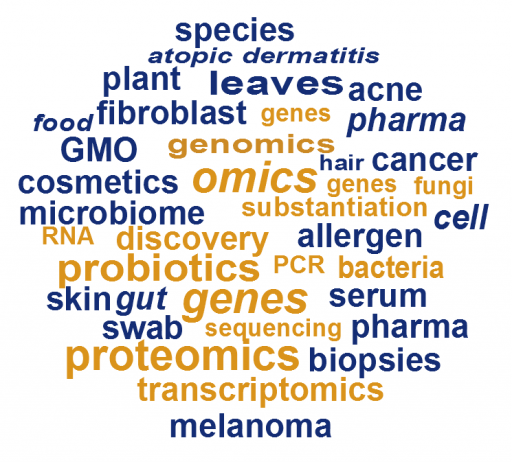News
 It is now well known that microorganisms present at the skin surface are in perfect symbiosis with the skin. We can even say now that skin is made of a human and a microbial part, this is the concept of the holobiont (2). Anyway microbes are the first range of protection against external aggression causing skin aging.
It is now well known that microorganisms present at the skin surface are in perfect symbiosis with the skin. We can even say now that skin is made of a human and a microbial part, this is the concept of the holobiont (2). Anyway microbes are the first range of protection against external aggression causing skin aging.
Metaproteomics is able to reach in an untargeted way both human and microbial proteins together, coupled with bioinformatics and AI data processing. Based on a relative quantification of proteins between conditions made by nanoLC-MS/MS, it allows to more precisely understand what are the mechanisms involved in effects.(3) (4)
Our publication with partners (1) shows by comparison of young and aged dehydrated skins and in protection or restoration by a powerful ingredient at the taxonomic and biological functional levels .
News
 As kinetics and level of expression of omics are different, the multi-omics tendancy is to couple different omics in order to paint a much more comprehensive and detailed picture of what is occurring between the host and microbes in healthy and diseased states(1).
As kinetics and level of expression of omics are different, the multi-omics tendancy is to couple different omics in order to paint a much more comprehensive and detailed picture of what is occurring between the host and microbes in healthy and diseased states(1).
Recently, new studies on skin used metagenomics coupled to metabolomics (2) (4). Of course metabolomics is attractive as being the final stage of the metabolization of substrates and reaching the molecular forms of exchanges within the microbiota and with the host. Even if limitations like only 10% of microbial and human metabolites being identified in the databases (5), it remains interesting to know more about for example fatty acids which are the most important components in maintaining the skin barrier function or lactic acid which is a key component of the skin’s natural moisturizing factor and keeps skin hydrated (4), or lipids as key components of the skin (3).
Then, it is logical to couple the omics which are in charge of the functions and which detect the production of the functions, namely metaproteomics and metabolomics(6), which will better track the host-microbes interactions (2), as metaproteomics reaches simultaneously the proteins of the skin and its microbiota which produce the metabolites to be detected. It is particularly efficient as it is often seen that there is no change at skin microbial abundance, taxonomic or functional metagenomics level but shifts appear at the real functional and metabolic levels , as discussed by these authors.(4)
PHYLOGENE is familiarin using the complementarity between metagenomics and metaproteomics to obtain more focused claims .
Now based on its expertise in metaproteomics, PHYLOGENE is completing its proposed services as close as possible to real functionality with metabolomics dedicated to skin metabolism . This metaproteomics and metabolomics toolset makes it possible to generate knowledge of the effects of skin diseases or the mechanisms of action of cosmetics, prebiotics, probiotics or drugs targeting the skin microbiome.
Metaproteomics:
Proteins are in charge of cellular structures and functions of life activities. Proteomics provides insights into the composition and activity patterns of intracellular proteins and protein-protein interactions.
Metaproteomics makes it possible to achieve simultaneously the identification of the microbiome members, and a snapshot of the functions of the host and its microbiomes. The non-targeted approach gives the identification and relative quantification of the host and its microbiome proteins impacted by the studied phenomenon and produces a set of data reflecting the studied effect.
Metabolomics :
Metabolites are the molecules produced by the functional proteome in response to environmental stimuli. Metabolomics is the final stage of the metabolization of substrates and identifies the molecular forms of exchanges within the microbiota and with the host. The proposed approach is a targeted approach of relative quantification metabolites known for their role in the skin metabolism.
Multiomics :
With coupled metaproteomics and metabolomics, we use the potential of the two omics closest to the phenotype.
Our bioinformatics tools enable integrated and standardized proteomic and metabolomic analysis of global proteome and metabolome data. Enrichment of metabolic pathways and correlation analysis of regulatory mechanisms of upstream protein actors of metabolism and downstream metabolite changes provide a comprehensive view of the effects generated at the gut level.
(1) Simran S Sandhu, Aunna Pourang, Raja K Sivamani. A review of next generation sequencing technologies used in the evaluation of the skin microbiome: what a time to be alive. 2019 Dermatology on line journal Volume 25 Number 7| July 2019| 25(7):1
(2) Jacques C and all. Multi-omics approach to understand the impact of sun exposure on an in vitro skin ecosystem and evaluate a new broad-spectrum sunscreen.
Photochem Photobiol. 2023 Jul 24. ;00 :1-14
(3) Patra V and all. Ultraviolet exposure regulates skin metabolome based on the microbiome. Sci Rep. 2023; 13: 7207.
(4) Li M and all. Multi-omic approach to decipher the impact of skincare products with pre/postbiotics on skin microbiome and metabolome. Front Med (Lausanne). 2023; 10: 1165980.
(5) Peisl BYL and all. Dark matter in host-microbiome metabolomics: Tackling the unknowns–A review. Analytica Chimica Acta Volume 1037, 11 December 2018, Pages 13-27
(6) Oleg Karaduta, Zeljko Dvanajscak,and Boris Zybailov. Metaproteomics—An Advantageous Option in Studies of Host-Microbiota Interaction. Microorganisms. 2021 May; 9(5): 980.
News
 PHYLOGENE to talk about omics technos for microbiome products effects substantiation
PHYLOGENE to talk about omics technos for microbiome products effects substantiation
News
 PHYLOGENE team proud to be awarded as best poster at Targeting Microbiota 2022.
PHYLOGENE team proud to be awarded as best poster at Targeting Microbiota 2022.
News
 Get your skin biopsies kit in your lab from CTIBiotech, apply your product, send the biopsies to Phylogene for proteomics analysis, receive your results from CTIBiotech and Phylogene
Get your skin biopsies kit in your lab from CTIBiotech, apply your product, send the biopsies to Phylogene for proteomics analysis, receive your results from CTIBiotech and Phylogene
News
 Our poster with partners at SID 2022 about the effects of an ingredient evaluated by metaproteomics and dedicated bioinformatics.
Our poster with partners at SID 2022 about the effects of an ingredient evaluated by metaproteomics and dedicated bioinformatics.
News
 DeepMicro: A project where Phylogene and the CEA will develop metaproteomics for understanding microbiomes
DeepMicro: A project where Phylogene and the CEA will develop metaproteomics for understanding microbiomes
News
 PHYLOGENE will be at IN-COSMETICS GLOBAL next April. Visit our stand P84 to see our innovations or don't hesitate to make an appointment, we will be even more available to discuss your past and future projects and find out if we can be of use to you.
PHYLOGENE will be at IN-COSMETICS GLOBAL next April. Visit our stand P84 to see our innovations or don't hesitate to make an appointment, we will be even more available to discuss your past and future projects and find out if we can be of use to you.
News
 Publication with partners on lipid metabolism in different types of skins exposed to sun using LC-MS/MS proteomics and lipidomics
Publication with partners on lipid metabolism in different types of skins exposed to sun using LC-MS/MS proteomics and lipidomics
Phylogene, founded 1999, is a biotechnology servicing company using genomics, transcriptomics, proteomics, metabolomics and bioinformatics techniques with the objective of developing methods of identification and ways to authenticate, or discover biological effects .
The applications are mainly the service to the food industry, health industry including in vitro diagnostics, cosmetics, environment industry as expertise or analysis and as kit developer to the diagnostics industry.
Accreditation COFRAC n°1-2128-testing- Scope available on www.cofrac.fr
